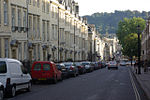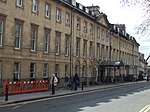The Circus, Bath
1768 establishments in Great BritainCrescents (architecture)EngvarB from January 2018Grade I listed buildings in Bath, SomersetHouses completed in 1768 ... and 2 more
Parks and open spaces in Bath, SomersetStreets in Bath, Somerset

The Circus is a historic ring of large townhouses in the city of Bath, Somerset, England, forming a circle with three entrances. Designed by architect John Wood, the Elder, it was built between 1754 and 1769, and is regarded as a pre-eminent example of Georgian architecture. The name comes from the Latin circus, meaning a ring, oval or circle. It has been designated as a Grade I listed building.The Circus is divided into three segments of equal length, with a lawn in the centre. Each segment faces one of the three entrances, ensuring a classical façade is always presented straight ahead.
Excerpt from the Wikipedia article The Circus, Bath (License: CC BY-SA 3.0, Authors, Images).The Circus, Bath
The Circus, Bath Kingsmead
Geographical coordinates (GPS) Address External links Nearby Places Show on map
Geographical coordinates (GPS)
| Latitude | Longitude |
|---|---|
| N 51.386 ° | E -2.364 ° |
Address
The Circus
The Circus
BA1 2ET Bath, Kingsmead
England, United Kingdom
Open on Google Maps










